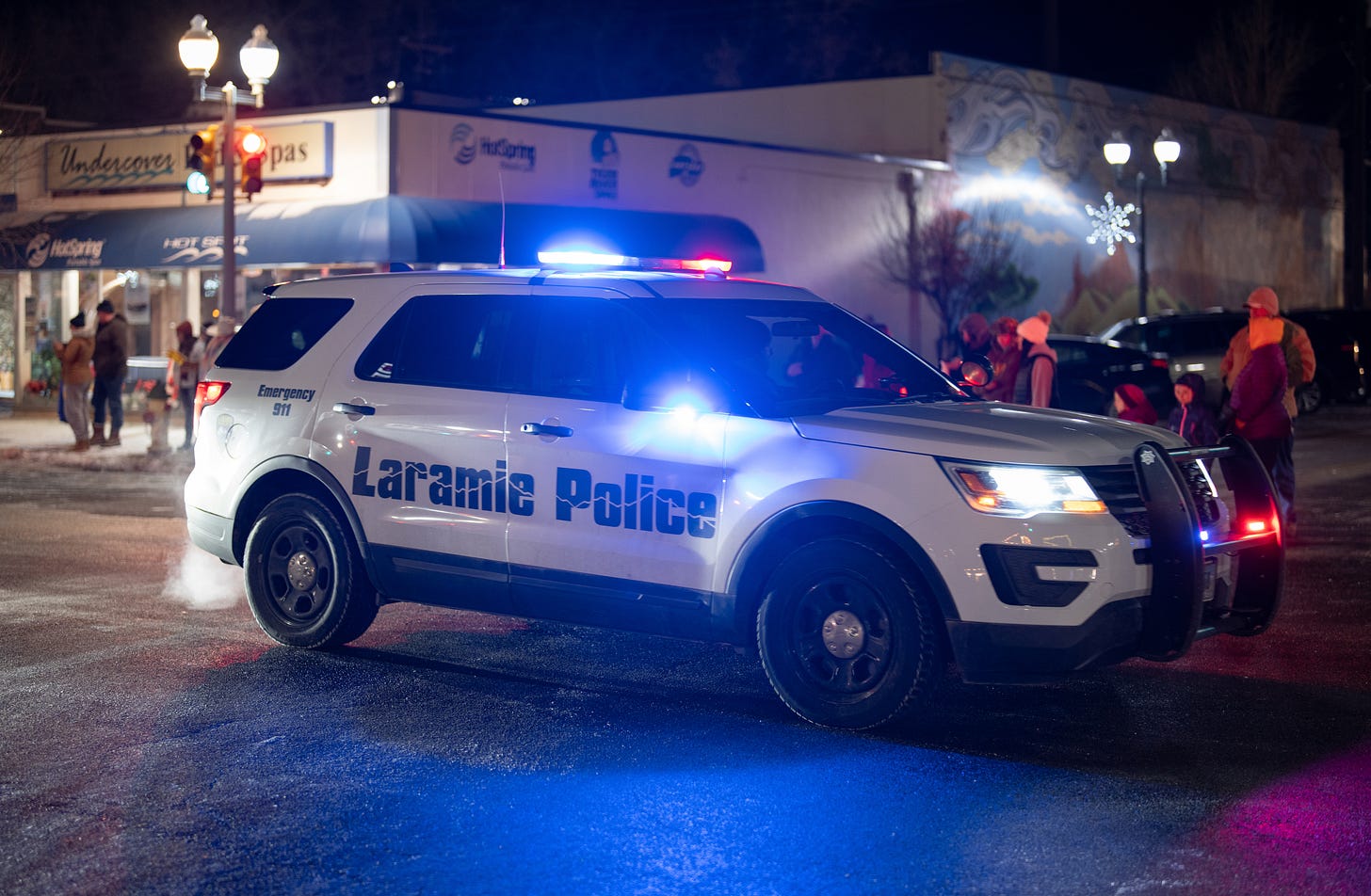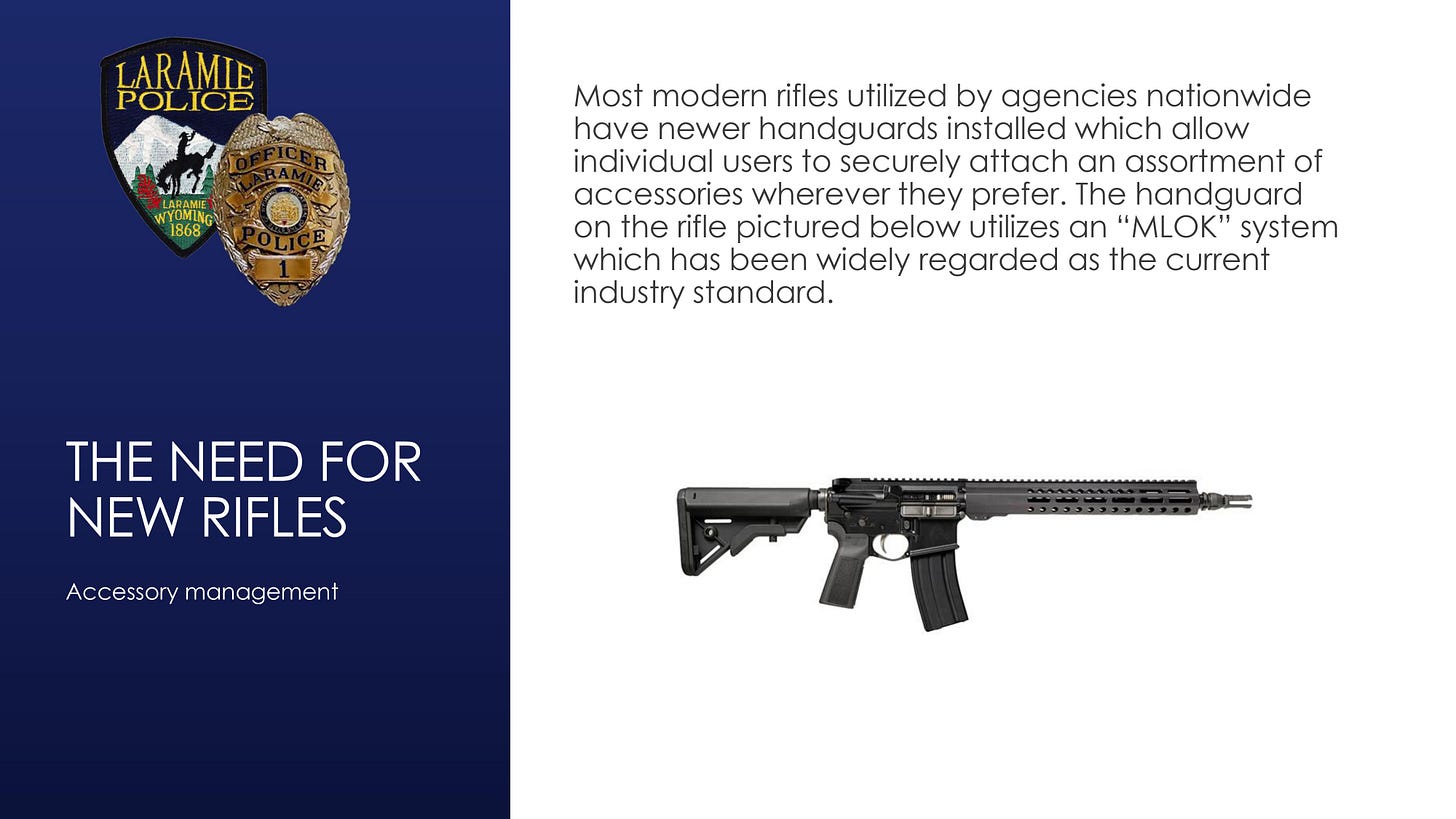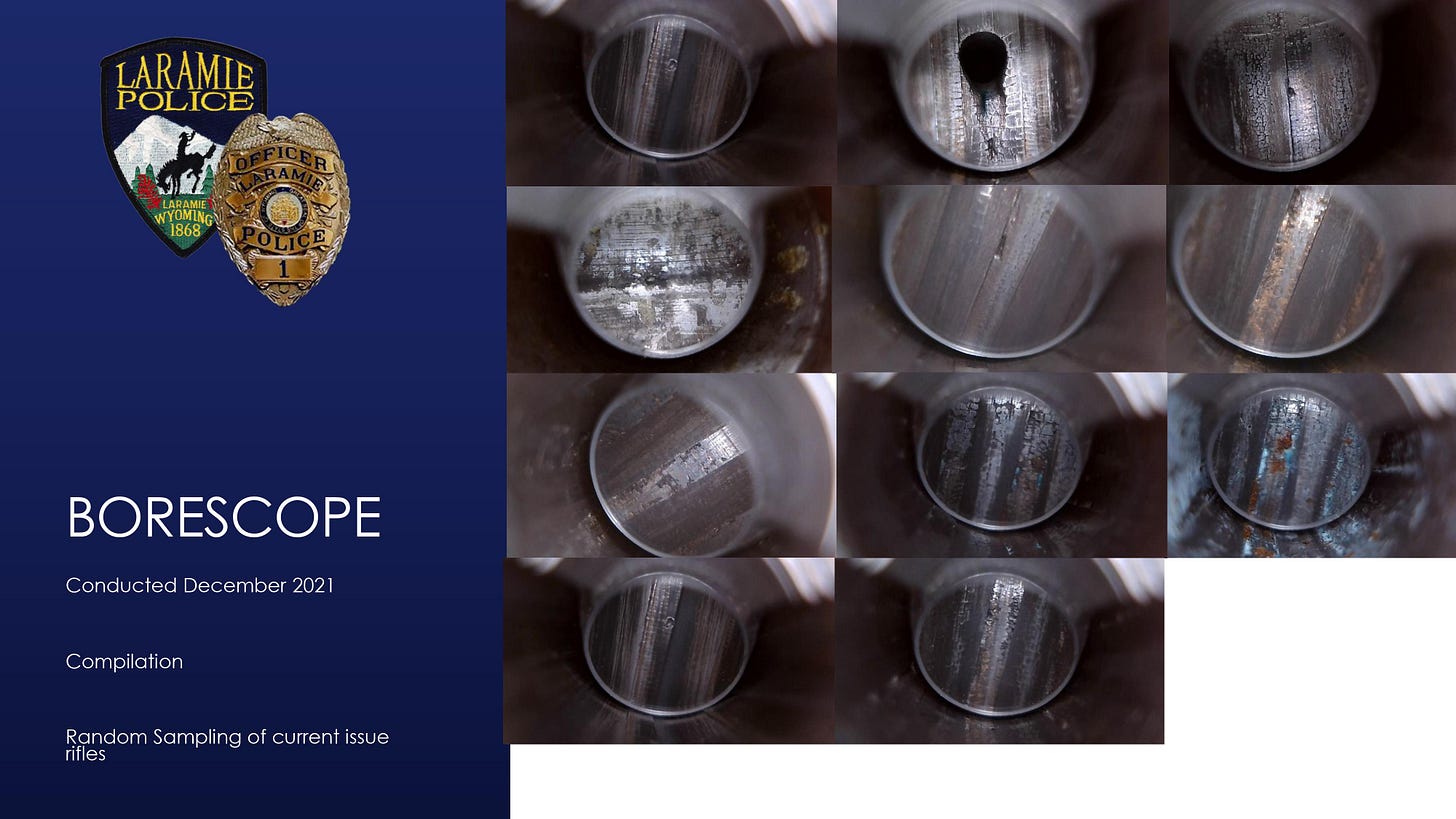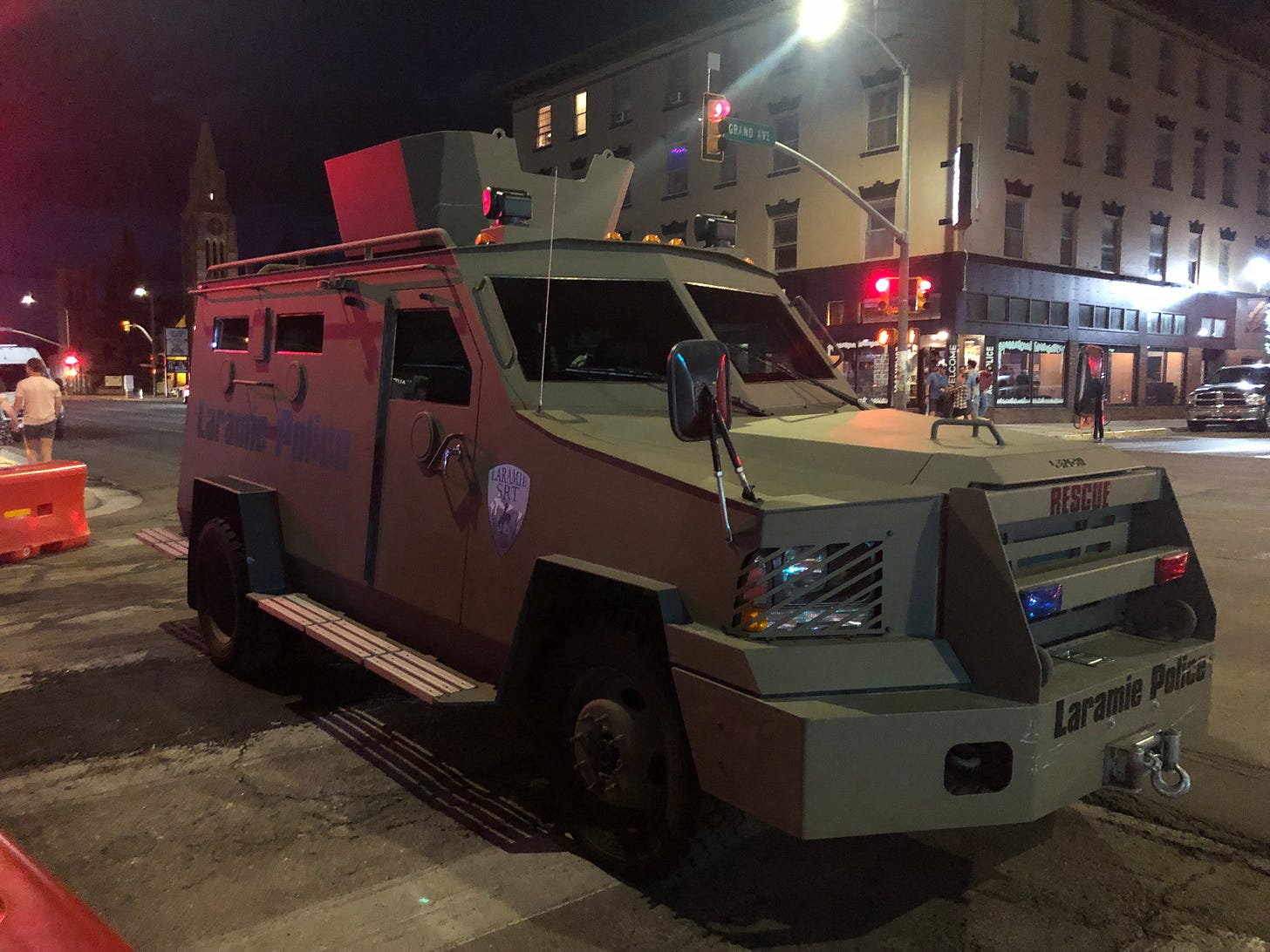LPD wants 50 new rifles, civilian advisors say it should get them
The current arsenal is a quarter century old and in bad shape. In a first of its kind proposal, LPD thoroughly explained its request and its rationale to a board of civilian advisors.

The Laramie Police Department is hoping to purchase 50 new semi-automatic rifles, replacing its current arsenal of deteriorating weapons with newer models that will allow for greater modularity.
In addition to sights and lights, the new armaments would be outfitted with suppressors, which LPD says are necessary to reduce hearing damage for the officers behind the trigger and any civilians in the immediate vicinity.
Last month, during the most recent Laramie Police Advisory Board meeting, Patrol Sergeant Jacob Bury delivered the department’s pitch for these new weapons. The proposal ultimately earned a unanimous recommendation from the advisory board, a civilian body tasked with translating police needs to the city council and the public.
The advisory board is a relatively new fixture for Laramie, established to foster greater public understanding of police actions. It represents a compromise, of sorts, between those who called for police oversight and those who insisted the police needed no oversight.
Bury opened his presentation with an extended discussion about why police need semi-automatic rifles rather than just handguns.
“The capability and the accuracy of the guns enhance officer and public safety,” he said. “Just looking around the country, you see all of the active shooters, you see hostages, and society as a whole is just getting more violent, it seems like. And patrol rifles allow us to deal with those situations with a little more precision and with a lot more distance.”
Currently, LPD has 62 patrol rifles — 45 made by Colt and 17 made by Rock River Arms. The new rifles and suppressors would be bought from Stag Arms, a Cheyenne-based manufacturer. The quote LPD received was about $64,000. That price tag is accounted for by a line in the recommended city budget that the Laramie City Council plans to vote on Tuesday.
LPD Chief Brian Browne briefly discussed the rifle line item during a presentation to council about his department’s budget.
“The lifespan for most military-style rifles, where they’re used continuously for range qualifications, is approximately 10-15 years,” Browne said. “We’re coming up on 25 years. Our oldest rifles are actually from 1998 and they’ve had approximately 15,000 rounds, conservatively, going through them. So, in short, it's time for some new equipment.”

The Laramie Police Advisory Board was established last summer to build trust between civilians and law enforcement. The idea is that LPD can bring proposals, such as this request for new rifles, before the board and explain its rationale. The board, an appointed group of five civilians, can ask questions and ultimately vote on whether they support the proposal or not.
In its first year, the advisory board has gained insight into the workings of the Laramie Police Department. The board’s members have participated in ride-alongs and gone through some police training. They’ve learned about hiring practices, internal investigations and more.
But when it comes to fostering trust in the police, Laramie doesn’t exist in a vacuum. There are concerns about modern policing — and a discourse much larger than the local community — that likely no amount of better communication with the public will solve.
But the presentation last month shed light on LPD’s thinking — about weaponry, about violence and about its responsibilities toward transparency.
A deteriorating arsenal
As an LPD firearms instructor and patrol rifle armorer, Jacob Bury is tasked with inspecting and repairing the rifles issued to every patrol officer.
“Over the last couple of years as I’ve been doing inspections and replacements on parts, I started noticing trends on parts of the guns that were breaking,” he told the advisory board, adding that this wear and tear affected various components of the gun, including extractors, gas tubes, hand guards and gas ports. Additionally, he said many of the rifles had experienced an erosion of their rifling, the texture inside of a barrel that spins the round and enhances accuracy.
Bury shared photos from nearly a dozen guns demonstrating these barrel deformities.

“Every gun that I pulled for sampling had something wrong with it, every single one of them,” Bury said. “There wasn’t any of them that showed, ‘This is in great condition, we should continue to use this.’ Every one of them’s like, ‘This isn’t good at all, we’re going to have a catastrophic failure.’”
So Bury got in touch with Colt, the manufacturer responsible for the majority of LPD’s rifles, and started reading off serial numbers to check each gun’s age.
“They said that their earliest date of manufacture was 1998,” Bury said. “Our most recent or newest gun is from the year 2000 — meaning that our newest gun is about 24 years old. In fact, when I was talking to the Colt people, I gave him one rifle serial number, and he said: ‘Let me know if you get rid of that, because we need it for our museum.’”
Bury argued newer guns would be safer for both officers and civilians, that newer models of the sort the department hopes to purchase from Stag Arms are built for greater modularity and designed to last longer, and that suppressors would protect officer and civilian ears while allowing those wielding the weapons to give commands and hear replies while on scene.
“Our goal in the Laramie Police service is to provide the best professional policing services to the citizens,” Bury said. “Part of that is obtaining and providing the best equipment and training to our officers, so that they can in turn provide the outstanding service that the community has come to expect. This proposal is designed to replace our old outdated tools with new modern technology that is adaptable to each officer, and is reliable so they can be counted on when lives hang in the balance.”
Rising violence and police militarization
The impetus for the rifle request is the condition of LPD’s current arsenal, but the rationale focused on the perception that police are in ever greater danger and the belief that this trend will continue to accelerate in the coming years.
Bury argued “society as a whole is just getting more violent” and this sentiment was echoed by ARK Regional Services CEO Bob Sell, who serves as a member of the advisory board.
“You look back at the last 25 years of law enforcement and how often people had to discharge a firearm, I don’t think that’s comparative data to where we’re headed,” he said. “I think the likelihood of having to use a firearm moving forward is going up exponentially. And that’s my concern about using any previous data and saying, ‘Hey, you don’t use it very often. So why do you need it?’ I think we’re looking at a future where they’re going to be deployed more often.”
But is this true?
Bury provided statistics from the FBI showing the number of law enforcement officers “feloniously” killed in the line of duty from 2010-2019. “Feloniously” meaning only those officers killed intentionally, so the data does not include other workplace fatalities officers experience, such as being struck by cars on the highway.
The data show 511 officers feloniously killed in the decade. In other words, across the United States, an average of about 51 officers were feloniously killed each year from 2010-2019.
Since 2019, more recent FBI data shows 46 felonious deaths in 2020, 73 such deaths in 2021, and 60 such deaths in 2022. That brings the average for the past 13 years up to 53, a slight increase over the average cited above. It should be noted that the 73 deaths in 2021 represent a high watermark. The second year of the pandemic saw more felonious officer killings than any of the previous 11 years.
Additionally, these figures do not account for the thousands of officers each year who are shot or otherwise injured but not killed.
So it might be true that it’s getting more dangerous to be a police officer, if only slightly.
However, rather than increasing numbers of hostage takers or active shooters, the growing danger might be due to the militarization of American police that has taken place in the last three decades.
Federal programs first established in the 1990s have funneled weapons and combat vehicles designed for war into local police departments — despite research showing that these weapons of war do not protect police and do not prevent crime and despite public criticisms that arming police like soldiers puts them in a “warrior” mentality.
But during the advisory board meeting last month, Chief Browne said military equipment is useful to law enforcement, even if its presence seems jarring at first.
“You start seeing equipment that you’ve never seen in a civilian setting before,” he said. “And ultimately, what does that do for us as law enforcement professionals? It gives us the ability to use the right tool for the right situation.”

Browne pointed to the recent student protests at Columbia University, where police used a Bearcat — a type of armored vehicle — to gain access to a campus building occupied and barricaded by students.
“The first thing I was thinking was, ‘Man that’s really aggressive,’” Browne said.
But as Browne heard NYPD officials explain in a press conference, the Bearcat was used to get officers into a second-story window, which saved them the hassle of tearing down barricades and possibly hurting students in the process.
“It made sense when you describe it,” Browne said. “But as administrators, we haven’t done a good job of justifying why we need these types of tools and weapons. It’s not because we want to be an occupying military force in our communities. It’s because we want our officers to be as safe as possible, and subsequently our community.”
But research suggests that militarization — the sudden presence of war weaponry and vehicles in a civilian setting — decreases a community’s trust in its police force. And possibly with good reason: militarized police departments are more likely to kill civilians than non-militarized agencies.
And killings by police are on the rise.
Trust and transparency in a deadly world
Simply put, in the U.S. in the last ten years, interacting with the police has gotten more dangerous. While those interactions might be getting slightly more dangerous for the officers, they are getting significantly and undeniably more dangerous for the civilians.
The University of Illinois Chicago runs the Law Enforcement Epidemiology Project through its School of Public Health, tracking and analyzing a variety of metrics surrounding threats to police safety and data on police shootings and violence. The project estimates police kill between 600-1,000 individuals in the U.S. every year, with that number trending steeply upward. It also notes that Black Americans are twice as likely to be killed by police and five times as likely to be hospitalized by police as white Americans.
Additionally, the Washington Post has maintained a database of fatal police shootings since 2015 — the year after a Ferguson Police Officer shot and killed Michael Brown in Missouri, sparking unrest in Ferguson as well as a nationwide movement to highlight and criticize police use-of-force.
(The 2014 protests also saw the rise of the Oath Keepers, a prominent right-wing extremist group that turned out during the unrest to patrol the streets of Ferguson. LPD Sergeant Jacob Bury, who led the rifle request presentation, is a former member of that group.)
Since Ferguson, killings by police have trended upward, even as calls for police reform have grown louder.
The Washington Post database notes 1,144 people have been killed by police in the past 12 months and highlights how that figure has been rising since the pandemic.
The majority of these killings by police do not occur during the gun battles one might imagine. A new study from the Johns Hopkins Center for Gun Violence Solutions published in the American Journal of Public Health finds:
Calls to police to check on the well-being of individuals were 74 percent more likely to be associated with fatal injury than police responses to an incident where shots had already been fired. This includes wellness checks that did not explicitly involve threats or harm before an encounter with police.
Police in Wyoming have killed 31 people since 2015, according to the Washington Post’s database, but none of those killings were carried out by the Laramie Police Department.
The Albany County Sheriff’s Office was responsible for two of those 31 deaths, and the sheriff has seen more deaths in the jail he’s responsible for, all of which have contributed to local mistrust of law enforcement.
While LPD has not killed anyone, the former police chief’s opposition to a proposed oversight board and the fact that said board was nixed out of fear that police would resign — as well as Bury’s former membership with the Oath Keepers and LPD’s communications surrounding that membership — have not made those predisposed to distrust law enforcement any more likely to trust LPD.
It’s not yet clear, one year in, if the new advisory board can foster such trust. But it has allowed for greater transparency on the subject of this request for rifles, as well as the rationale behind that request.
Without Bury and Browne’s presentation to the advisory board — a recording of which is publicly available through the city’s agenda center — this $64,000 line item in the city’s $107 million budget would not have received a spotlight.
It might not have made the news or allowed for this analysis of police decision-making.
The advisory board itself is aware of its unique and new role in Laramie and, during the same May meeting, discussed plans to develop a more public face.
For his part, Chief Browne told the advisory board he recognized there are community concerns about the militarization of police and wanted to be transparent about an arms purchase that looks, and is, big.
“I want to make sure that when councilors approve this, they have as much information as possible, and you have as much information as possible,” he said. “And that way, nobody’s getting caught off guard.”
The city council is slated to vote on the budget Tuesday.






I really have no respect for Laramie, for the Laramie Police Department or for the Laramie Municipal Court (including city prosecutors and judges): not after I was framed in a false police report in retaliation for my ending the career of a DCI terrorist who was threatening a Warren AFB family- after he had threatened me anonymously on the phone for opposing a concealed weapons bill pending in the Wyoming house. The LPD police report said I threw a cup of hot coffee in the face of a woman who had just tried to drive me off Snowy Range Road as her criminal (Arizona) boyfriend made a video. In court, the lying LPD cop was counseling the woman and when I (sitting the back of city court) objected spoke up the greasy liar threatened physical violence, removing me from the court . A dental technician in Laramie told me her LPD husband was seeing first hand the corrupt manipulation of test scores by LPD Chief Stalder (so he could keep favored cops under his thumb; the cop who had filed false report about me had left Laramie. In September, 2009, my car was attacked on the summit of I-80 (for murderous PIT maneuver) by DCI porn cop Robert Leazenby who told me that his (illegal in Wyoming) unmarked car "stop" was "something we can do to you any time we like." That lousy cop was once an Albany County deputy and I believe he was fired for tampering with evidence . Wyoming is the #1 state in USA for guns per-capita and the (always top 5) sickest in the nation for suicide, mental illness and industrial accidents. People in Wyoming don't have to think clearly. They just "do the right thing?" Ha! This article is about the matter of arming Laramie cops with a new level of paramilitary firepower. Behind this emphasis, state-wide is probably the "emeritus" voice of fired DCI Deputy Director Kebin Haller (who- after I ended his career at DCI- was promoted by paramilitary .50 cal sniper rifle Governor Mead to running the highway patrol so Haller would both get high retirement AND be able to corrupt the culture of every police department in the state! I suggest journalists ask who was paid off for this up-arming; and are the old guns going to be destroyed? NO! They're going to be resold into a criminal market of second hand semi-auto AR15s!
One of my favorite questions to ask people I meet, especially older ones, is "Were more police officers killed under the 8 years of Barack Obama or the 8 years of Ronald Reagan?"
The deaths of police officers has dropped significantly since the crime-ridden 70-90s time frame; however, most citizens refuse to believe things have gotten much safer across America. What the data screams to me is that the tactics used to address domestic violence calls needs addressing as the rise in murders during the pandemic was not marauding gangs like Chris Wray the head of the FBI would have one believe, but due to 8 million new guns going into users hands as a pandemic drove families to kill each other.
SOCIETY is not getting more violent, but society has pushed Americans into selecting the worst possible stimulant in the world Meth, which makes individual users far more violent than they would be if they were selecting another stimulant like Cocaine. Hamas fighters were trained to hate, rape and murder using a Meth like derivative, but we US citizens are not connecting those dots, instead we are buying fear and arming up.
Old Bob Sell and Bury have not parsed the data accurately but hey its America where discussion of drug interactions that result in a more violent citizen are not considered. However, in Australia, one can find this nuanced discussion from engineers studying the drug habits of its citizens through waste water treatment analysis. (https://www.acic.gov.au/sites/default/files/202403/Wastewater%2021%20FOR%20WEB2.PDF)
"The 1.5 tonne increase in national methylamphetamine consumption is concerning, because of the significant community harms it causes."
America has been far behind in discussing the drivers of violence and what is the best way to respond and the police oversight board seems to prove that Laramie will buy into fear instead of discussing reality.
173 more officers were killed under Ronald Reagan's tenure than Barak's tenure and America's response was to militarize the police workforce and equipment, driving up operational costs while doing little to address the root causes of violence and police ineffectiveness.